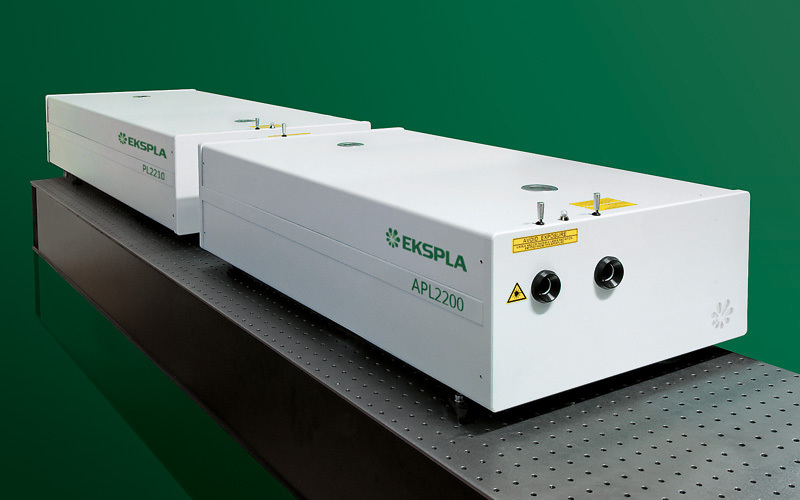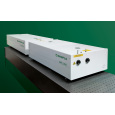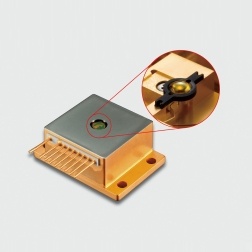方案详情
文
采用立陶宛Ekspla公司的PL2201JE型千赫兹高重复频率皮秒脉冲激光器的二倍频355nm输出的激光束,聚焦后和电压脉冲交替施加在钨金属靶上,观察所产生离子的飞行时间谱特征。
方案详情

Accepted: 21 August 2018Received: 16 August 2018DOI: 10.1002/sia.6559WILEYSU CEandIN ERFACCEANNAI IS 106TANIGUCHI AND NISHIKAWA Alternate field evaporation by changing laser pulsing andvoltage pulsing dynamically for atom probe analysis M. Taniguchi(D|O.Nishikawa Department of Chemistry and Biology,Kanazawa Institute of Technology, Nonoichi921-8501, Japan Correspondence M. Taniguchi, Department of Chemistry andBiology, Kanazawa Institute of Technology,Nonoichi 921-8501,Japan. Email: taniguchi@neptune.kanazawa-it.ac.jp Time-of-flight mass analysis in atom-by-atom scale is performed in atom probe (AP) bypulsed field evaporation of sample material. The pulsed field evaporation is triggeredby superposing voltage pulse or shooting laser pulse together with stationary voltagefor evaporation field. Voltage pulse which has been used from the establishment ofAP in the 1960s is going to be replaced by short pulsed laser with high repetition ratein the nanometer scale characterization of materials by 3-dimensional AP. The criterionfor choosing appropriate trigger method is not clear because it is difficult to comparethe result of 2 triggering method applied on the same sample in atomic scale. The pre-cise comparison of 2 triggering method was enabled by applying voltage pulse andlaser pulse alternately to the identical sample. The results of composition and spatialinformation reflected the mechanism of assisting field evaporation. But the evapora-tion order was almost random or disordered showing no correlation between 2triggering method. To make clear the correlation between voltage pulsing and laserpulsing, the authors report their new system forcing alternate evaporation switchingto the other trigger after the detection of ion in 1 trigger between voltage and laser. 1IINTRODUCTION Time-of-flight mass analysis in atom-by-atom scale is performed inatom probe (AP) by pulsed field evaporation of a sample material.The pulsed field evaporation is triggered by superposing voltagepulse or shooting laser pulse together with stationary voltage forevaporation field. Voltage pulse which has been used from theestablishment of AP in the 1960s is going to be replaced by shortpulsed laser with high repetition rate in the nanometer scalecharacterization of materials by 3-dimensional AP (3D-AP).1.2 Thecriterion for choosing appropriate trigger method is not clear andunder discussion because it is difficult to compare the result of 2triggering methods applied on the same sample in atomic scale.The precise comparison of 2 triggering methods was proposedby the authors by applying voltage pulse and laser pulse alter-nately to the identical sample. The results of mass spectrometriccomposition and spatial information of desorbed ions reflected themechanism of triggering field evaporation. But the evaporationorder was almost random or disordered showing no or little corre-lation between 2 triggering methods applied alternately duringanalysis. To make clear the correlation between voltage pulsing and laserpulsing, the authors report their new system forcing alternate evapo-ration by switching to the other trigger after the detection of ion in1 trigger between voltage trigger and laser trigger. In this paper,application of laser trigger and voltage trigger alternately pulse bypulse manner introduced in our former system is called “alternatetriggering."In the new scheme "alternate evaporation,”1 trigger isapplied continuously until the desorbed ion is detected and the triggeris switched to the other when an ion is detected. In the same period of the authors work, Zhao et al also reportedthe combination of a laser pulse and a voltage pulse. Their systemapplied 2 pulses absolutely in the same timing on the same sample.They reported that the pulse electric field reached the apex of thesample of poor conductivity in which the laser illumination gave riseof temporal conductivity by thermal jump and carrier formation. These2 approaches "on the same identical sample” use similar experimentalequipment in common, but the experimental setup is very differentand the scope of the works are also different. The function of components enclosed by dashed line is replacedby trigger controller box newly built utilizing field programmable gatearray (FPGA). 2 l|EEXPERIMENTAL SETUP The schematics of the instrument used in this work is shown inFigure 1. The fundamental feature of scanning AP is described else-where. The specimen is positioned in front of the small probe holeof the miniature electrode by XYZ stage with inertial drive piezoelec-tric actuators. The analyses were performed at 160 K. The time offlight and the hit position of field-evaporated ions are detected bydelay-line-type 2D-position sensitive detector (DLD) by lonwerks ofUSA (“Meander"). The start (trigger) time and stop (hit) time arerecorded by time-to-digital converter (TDC) of 25-picosecond timeresolution (TDC2PCI, Roentdek, Germany). Both control/data acquisi-tion and data analysis program are written in our laboratory. In the previous setup for alternate triggering, a programmable dig-ital delay (DG535, Stanford Research, USA) enclosed in dashed line inFigure 1 received the time base signal from pulsed laser (入= 535 nm, second harmonics of Nd:YAG, Ekspla PL2210JE). The trigger signalreturned from digital delay to laser to give a shot of laser to specimen.The digital delay generated a trigger ID signal, and the next logic pulseis sent to voltage pulser (Hamamatsu Photonics). The trigger ID signalis simultaneously sent to TDC to identify the trigger source of eachdetected ion. For the control of alternate evaporation, the system has to fetchan evaporation event which occurs at the rate of around 1evaporation per 100 trigger pulses before sending next trigger to laseror voltage pulser. To do this, the digital delay in the previous system isreplaced by the active control system utilizing the FPGA (AlteraMAX10). The FPGA chip fetches hit signals from DLD via the signaldiscriminator (Philips Scientific #715) and switches the trigger sourceto the other. The system operates at the clock of 100 MHz whichenables the response of every 10 nanoseconds and runs indepen-dently of the ToF data acquisition system working in PC. The FPGA Trigger Control TTL Level box controls/switches only trigger source and time of flight of ions,and other information are treated by TDC and PC as previous system. The amplitude of positive DC bias and voltage pulse is automati-cally controlled by the data acquisition system in PC so as to keepthe ion detection rate constant typically less than several ions per100 triggers.The pulse fraction was fixed to 0.23 of the total voltage.The laser pulse amplitude is manually adjusted to keep the same rateas that of voltage pulse. Both laser and voltage pulsers are triggeredat 1 kHz. The control mode can be switched between alternatetriggering and alternate evaporation in FPGA box. 3 RESULTS AND DISCUSSION 3.1 AAlternate triggering The charge state and elemental composition of cluster ions detectedby alternate triggering which can be summarized in mass spectrashowed a significant difference between laser triggering and voltagetriggering performed in a single analysis.1 The major componentappeared in each trigger was almost consistent with conventionalclassification for laser or voltage pulsing. According to the mass spec-tra, it is clear that the triggering method has influence on desorptionmechanism of ions. Figure 2 shows the frequency distribution of sequentiallydesorbed ions by voltage trigger or laser trigger counted from a dataset of AP data in a single analysis applying voltage pulse and laser pulsealternately of (a) metallic sample: tungsten and (b) nonmetal, nonbulksample, L-tryptophan supported on carbon nanotube. The ions arecounted irrespectively of mass to charge ratio here. The horizontalscale of the graph shows the number of ions successively detected inthe data sequence. In the alternate pulse sequence of laser (l) andvoltage (v), when 2 ions are detected by voltage pulse (V) ("L”for laserpulse detected ion) like this, l-v-L-v-/-V-I-v-/-V-I-v-L-v-/-v-l-v-, it isassigned that 2 ions (V) are sequentially detected by voltage pulseregardless of the invalid triggers (-l-v-I-). The dashed line shows the sta-tistical model in which ions are randomly desorbed by laser or voltage. The distribution seems almost random, and there is no significantinfluence of past trigger to next trigger though the frequency of eventin which more than 10 ions were successively detected is slightly large in tungsten. The influence or "memory" of former desorption is alsonot clear. This result is reasonable or acceptable in a sense becausethe trigger amplitude should be adjusted to make no damage tosample structure. The spatial distribution of ions desorbed from metallic sampleshows that there is a correlation between 2 triggers. To extract the dis-tribution difference, the relative displacement of hit position of ions onthe detector plane is plotted with white dots in Figure 3. When laserdesorption appears next to voltage desorption, the relative positionbetween 2 hit is extracted and plotted taking the origin at the centerof the square in the left panel“(V)->L"of Figure 3. In the same way,the right panel"(L)->V"shows the case of voltage desorption after laserdesorption. The mass center of ions is located in bottom side for laserand top side for voltage, respectively. These distributions indicate thatthere is some spatial correlation between 2 triggering in which voltagedesorption is compensating curvature distortion induced by thermalanisotropy caused by laser beam coming from bottom direction. 3.22 Alternate evaporation Figure 4 shows the time course during alternate evaporation. High-voltage pulser and pulse laser are triggered at L to H transient of con-trol signal from FPGA box. The mass spectrum and the ladder diagram FIGURE 3 The relative position distribution of ions of tungsten ondetector plane during alternate triggering. The origin of the plot islocated at the center of the square field. Left:laser-desorbed ions aftervoltage-desorbed ion. Right: voltage-desorbed ions after laser-desorbed ion No. of lons in One Sequence of tungsten analysis are shown in Figure 5. The mass resolution forlaser-desorbed ions is better than that for voltage-desorbed ions inalternate evaporation analysis as in the alternate triggering analysis.The ion counts are almost linearly increased for both voltage(w3+and w4) and laser (w2+andW3). Figure 6 shows the frequency distribution of sequential ions inthe data set. The dashed line is the statistical model in which ionsare randomly desorbed by laser or voltage as in Figure 2. If the alter-nate evaporation system works perfect, the ion by voltage and theion by laser should be aligned alternately in the data record. Thismeans that the frequency of event which consists of 2 or more ionsmust be zero in a perfect data set. Though the observed frequenciesof a single ion for both laser and voltage are dominant and thedecrease of frequencies is much steeper against the number of ionin 1 sequence in Figure 6 than in Figure 2, multiple ions more than 3are also found in data set. The spatial information obtained on tungsten by alternate evapo-ration is shown in Figure 7. To deal with the voltage pulsed ions andlaser pulsed ions in the same context, the reconstruction was doneby using only the value of stationary voltage. The simple protocol ofpoint projection model was used for reconstruction.’ The latticespacing stripe is clearly observed in the “laser-voltage composite"reconstruction. As in the alternate triggering analysis, the spatial FIGURE 6 Frequency distribution against the number of ionssuccessively detected from tungsten tip specimen by voltage pulseor laser pulse in alternate evaporation mode information is preserved also in alternate evaporation analysis using2 trigger sources. To check the correlation of X-Y coordinatesbetween laser-desorbed ion and voltage-desorbed ion, the same plotas Figure 3 was examined also for the alternate evaporation data.But the extracted plot showed only small (difference betweenlaser-desorbed ion and voltage-desorbed ion. Proceeding of AnalysisS— FIGURE 7 Three-dimensional reconstructed distribution of tungstenions by alternate evaporation using voltage pulse and laser pulse. Theanalysis proceeds from left to right of the horizontal axis of the plot 3.31 Comparison between 2 triggering modes The alternate triggering is a simple procedure, and the data acquisitionsystem receives the data passively. So, the procedure of alternate trig-gering is precise, and there might be small variation in experimentalconditions except the tuning of trigger amplitude keeping a balanceof the desorption rate for laser and voltage. On the other hand, the trig-ger amplitude adjustment is not a serious problem in alternate evapora-tion mode. Therefore, there might be a variation of protocol foralternate evaporation. The hit-by-hit switching between laser triggerand voltage trigger (L,V,L,V,....) demonstrated in this work is the simplestsequence. If the selectivity of ion species by trigger source is useful foran analysis of composite material, the number of ion detection in singletrigger sequence might be optimized to obtain better result inelemental composition. Therefore, in the future work, optimization ofswitching sequence such as LLL,VV,LLL,VV,.... will be examined. The detection order of laser and voltage is not perfect in alternateevaporation as can be seen in Figure 6. There might be 2 reasons forthe disorder of detection sequence in alternate evaporation. Onereason is that the incomplete judgment of ion detection systemproduces ghost data record or missing data set. Although the presentsystem checks the MCP and DLD signals during AP analysis whetherthey are self-consistent or not before switching the trigger source,the time resolution (10 nanoseconds) is not good enough to reject afake signal and to suppress miss switching. If 1 data record (L) in theseries of ion data (-V-L-V-(L)-V-L-V-) is found incomplete in data recon-struction, it is discarded to bring about the emergence of sequential 2voltage data (-V-L-V--V-L-V-). The time resolution and the hit judgmentcriteria of the system setup should be improved in future work. On the other hand, the limitation of detection efficiency (less than50%) of the system, which is mainly restricted by MCP opening area, isnot easy to be evaluated and to be overcome. If the desorbed ion hassome irregular offset angle in trajectory, also the limitation of angular area of the position sensitive detector causes the loss of ions. The lat-ter factor implies that the “real" evaporation sequence includes somedeficit ions which are not recorded in data set even though the dataset seems perfect in the sequence analysis. Both combined application of laser and voltage trigger pulsing,alternate triggering and alternate evaporation show the preservationof spatial information as in the normal analysis using laser or voltagepulses as a single trigger source. The shape deformation from conicallysymmetric to asymmetric caused by laser illumination from 1 directioncan be reduced by the alternate application of voltage pulse. The chargestate difference is clearly demonstrated also. Although the merit ofalternate application of 2 trigger is not clear now in the analysis of bulkmaterial of 1 element as shown in this work, the composite specimensuch as molecular species supported on carbon materials might be agood candidate for the demonstration of trigger selectivity. ORCID M. TaniguchiDhttp://orcid.org/0000-0003-2700-0740 ( REFERENCES ) ( 1. Mueller E e t al. T he atom p robe field ion microscope. R ev Sci I nstrum. 1968;39(1):83-86. ) ( 2. Kellogg GL. D etermining the f i eld e mitter t emperature d u ring l a ser irradiation in the pulsed laser e r atom probe. e . J Appl Phys. 1981;52(8):5320-5328. ) ( 3 . Mayama N, Kajiwara Y, M i kami S, et al. Dependence of field evaporation voltage on p olarization angle of femtosecond laser in 3D a tom probe.E- J . Surf. Sci. Nanotechnol. 2009;7:70-73. ) ( 4. Mayama N, T e rakawa T, Morita M , O w ari M. In f luence of t i p tempera- ture on f ield evaporation in atom probe. E-J S urf S ci Nanotechnol. 2011;9:375-379. ) ( 5. Morita M, K urasawa M, Asaka T, Owari M, Sur J. Analyst. 2014;20:177. ) ( 6. Taniguchi M, N ishikawa O. S c anning atom probe ana l ysis alternately triggered b y voltage and la s er pulse. e-J. o f Surf. Sci and N a notechnol. 2016;14(0):69-72.https://doi.org/10.1380/ejssnt.2016.69 ) ( 7. Zhao L , Normand A , Houard J, Blum I, De l aroche F, V ur p illot F. Nanoscale p hotoconductive switching e ffect a pplied to atom p robe tomography. Europhysics Lett. 2016;116(2):27002. ) ( 8. Nishikawa O,Ohtani Y, Maeda K, Watanabe M , Tanaka K. Development of the scanning atom probe and a t omic level analysis. Mater Charact. 2000;44(1-2):29-57. ) ( 9. Bas P, Boste l A. Deconihout B. Blavette D. A ppl y s s urf f S ci. 1995;298:87-88. ) How to cite this article: Taniguchi M, Nishikawa O. Alternatefield evaporation by changing laser pulsing and voltage pulsingdynamically for atom probe analysis. Surf Interface Anal.2019;51:105-109.https://doi.org/10.1002/sia.6559 urf Interface Anal.wileyonlinelibrary.com/journal/sia John Wiley & Sons, Ltd. FIGURE Schematics of KIT scanning atom probe Time‐of‐flight mass analysis in atom‐by‐atom scale is performed in atom probe (AP) bypulsed field evaporation of sample material. The pulsed field evaporation is triggeredby superposing voltage pulse or shooting laser pulse together with stationary voltagefor evaporation field. Voltage pulse which has been used from the establishment ofAP in the 1960s is going to be replaced by short pulsed laser with high repetition ratein the nanometer scale characterization of materials by 3‐dimensional AP. The criterionfor choosing appropriate trigger method is not clear because it is difficult to comparethe result of 2 triggering method applied on the same sample in atomic scale. The precisecomparison of 2 triggering method was enabled by applying voltage pulse andlaser pulse alternately to the identical sample. The results of composition and spatialinformation reflected the mechanism of assisting field evaporation. But the evaporationorder was almost random or disordered showing no correlation between 2triggering method. To make clear the correlation between voltage pulsing and laserpulsing, the authors report their new system forcing alternate evaporation switchingto the other trigger after the detection of ion in 1 trigger between voltage and laser.
确定
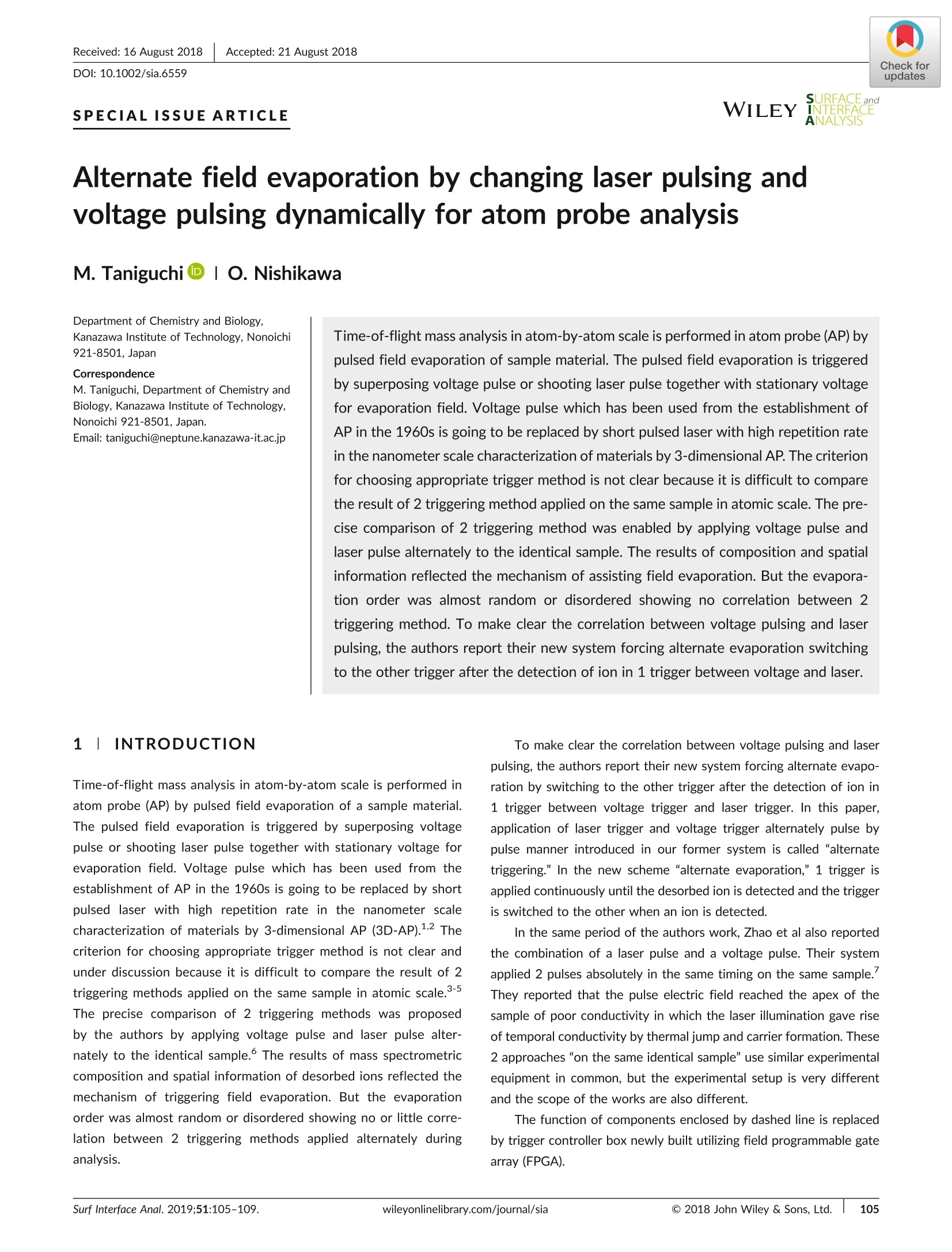
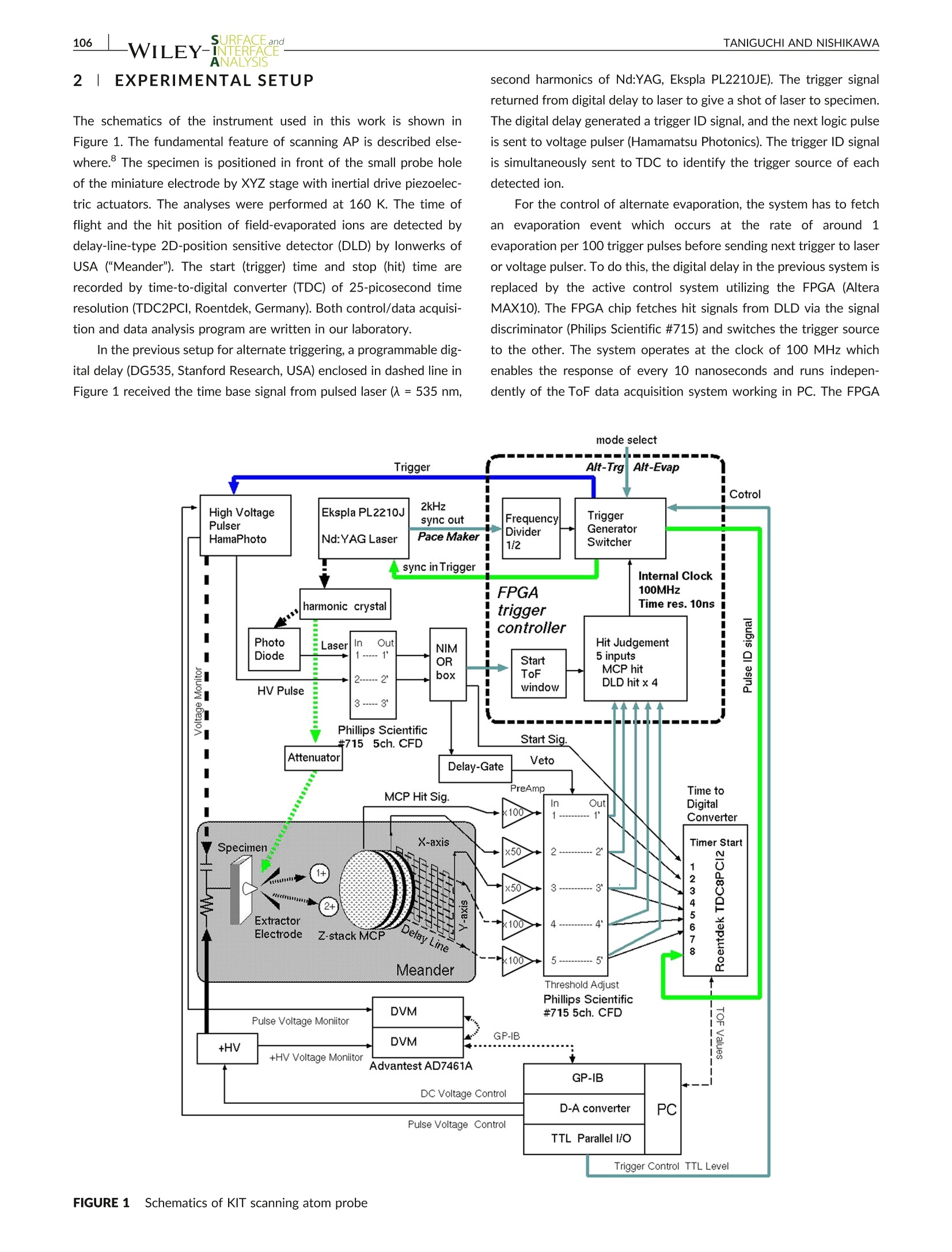
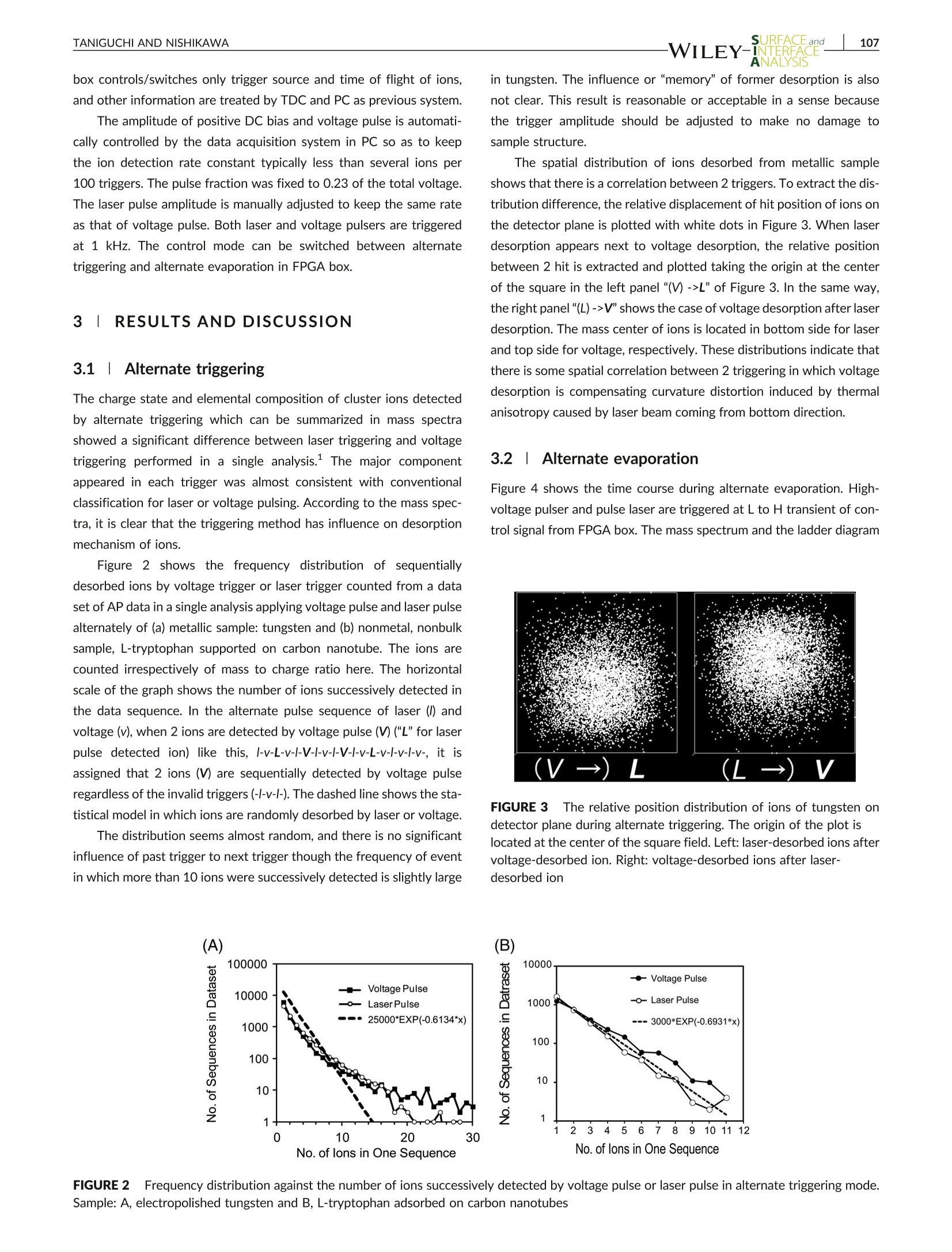
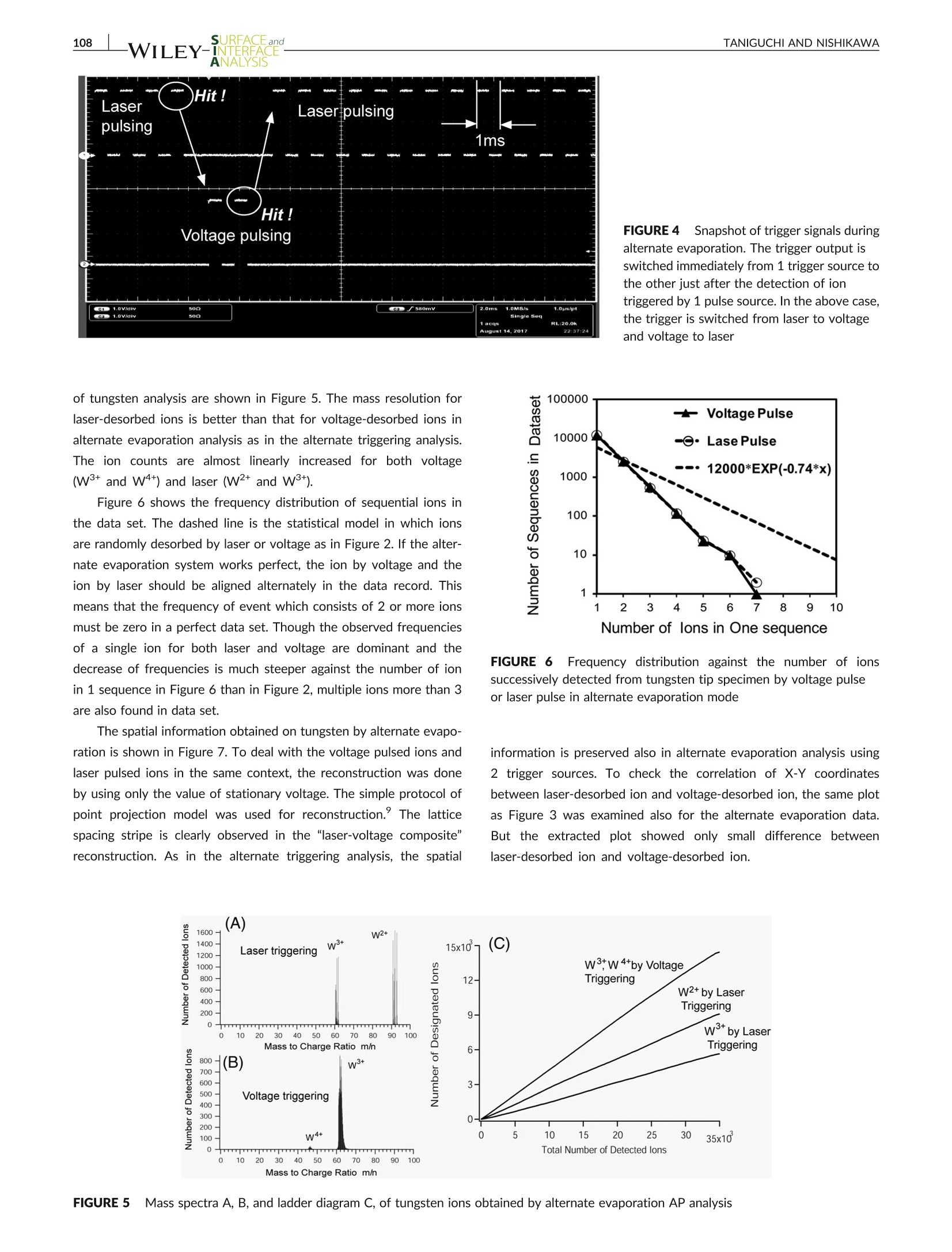
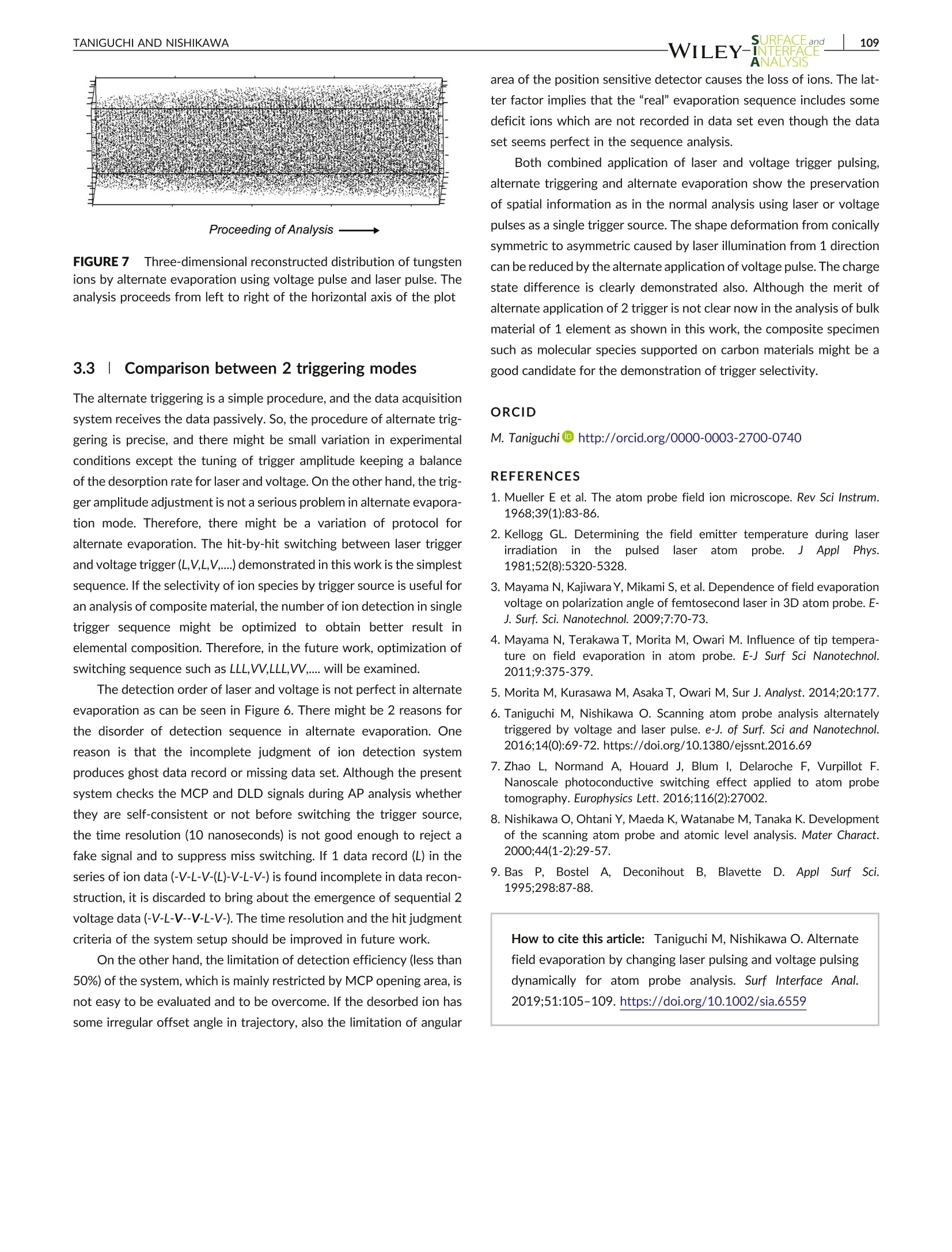
还剩3页未读,是否继续阅读?
北京欧兰科技发展有限公司为您提供《钨靶中离子时间飞行谱检测方案(激光产品)》,该方案主要用于其他中离子时间飞行谱检测,参考标准--,《钨靶中离子时间飞行谱检测方案(激光产品)》用到的仪器有Ekspla APL2200 高能量千赫兹皮秒放大器
推荐专场
相关方案
更多
该厂商其他方案
更多

